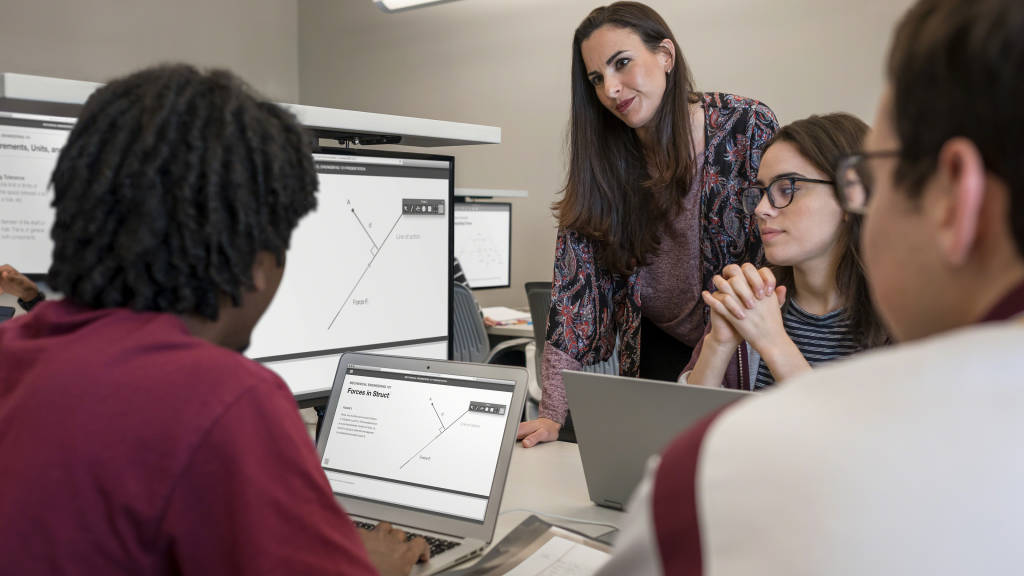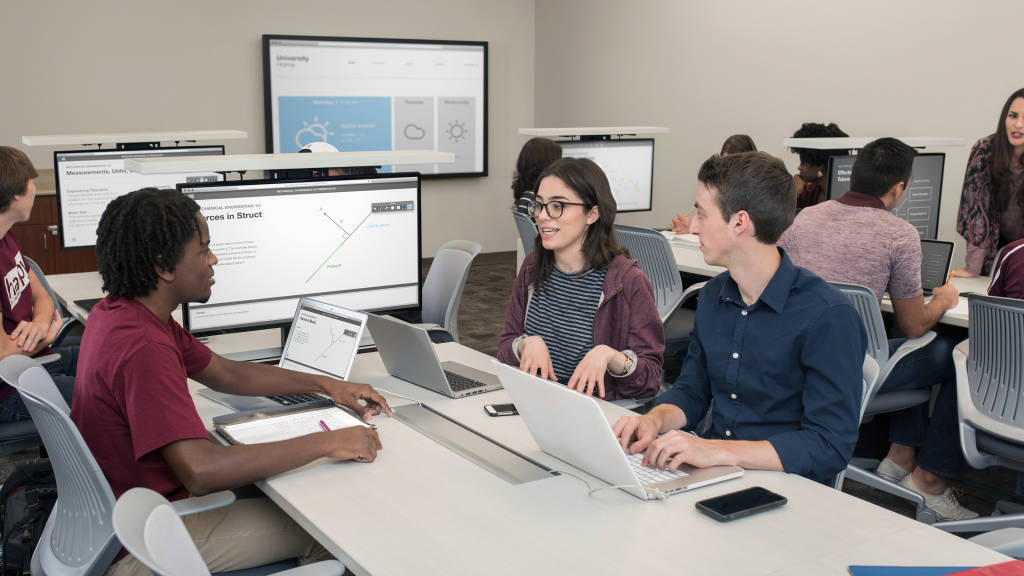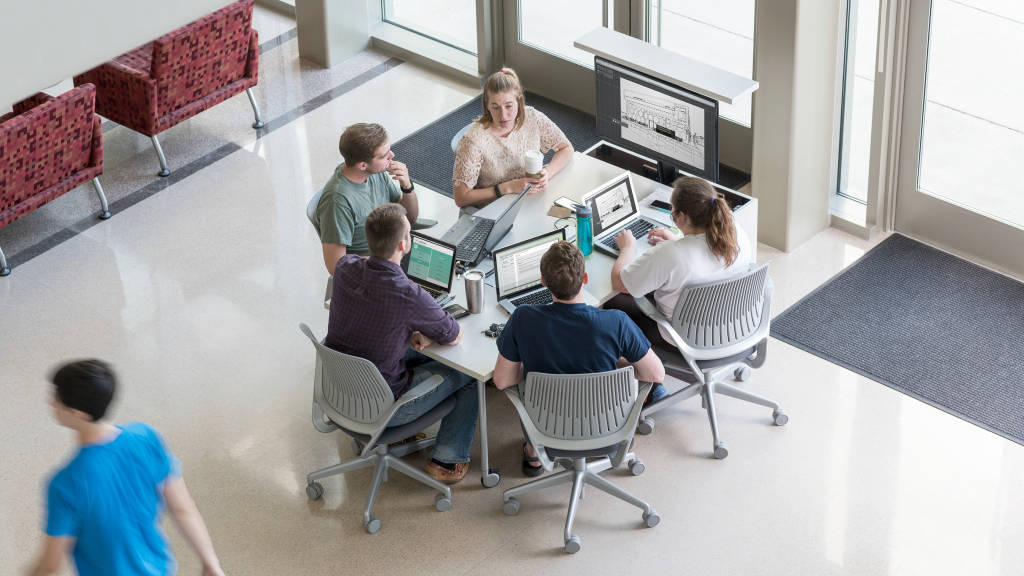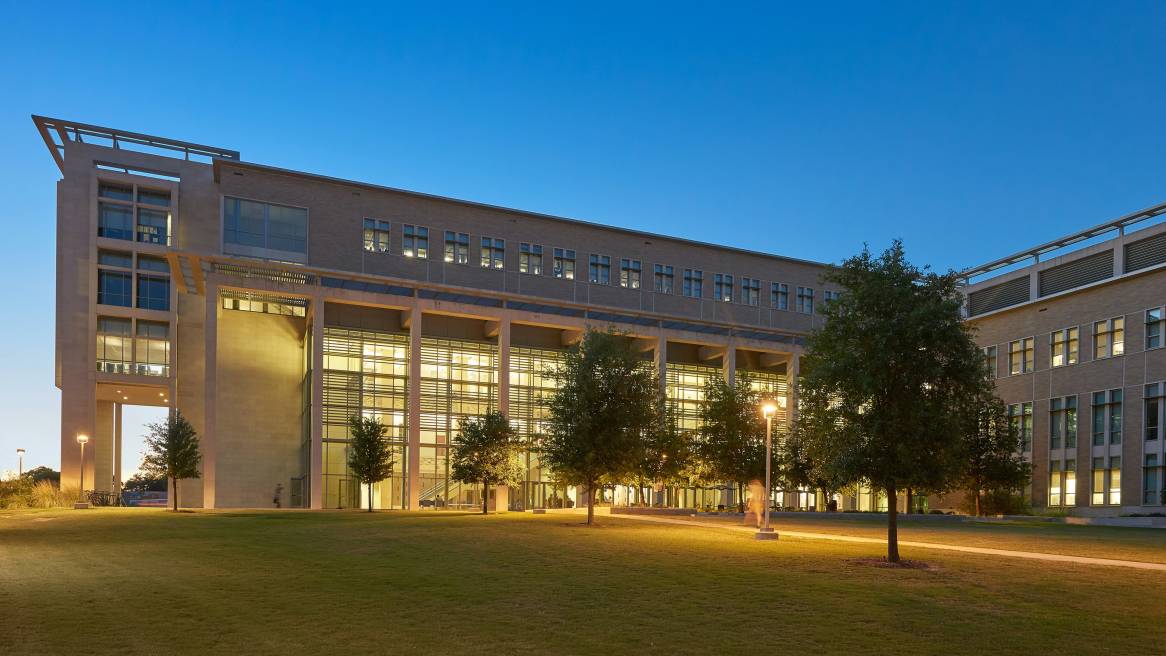Active Learning at Scale
Large active learning classrooms and a custom table solution from Steelcase help transform the educational experience at Texas A&M University
With one of the top rated engineering programs in the U.S., Texas A&M University plans to increase its engineering student population by more than a third, to 25,000, by 2025. Half of this growth is expected to come through improved student retention, the result of the college’s strategy to “transform engineering education.”
The centerpiece of this effort is the new 525,000 sq. ft. Zachry Engineering Education Complex, which avoids traditional classroom and lecture hall approaches and instead features large, active learning classrooms and furniture that fully integrate technology.
“I’m not sure anyone has tried to integrate technology and active learning on this scale before,” says Edwin Pierson, CIO and director of information technology at the College of Engineering. “We’re building learning environments that work for the different ways students learn, whether it’s interactive, collaborative on a large or smaller scale, or lecture. These are environments that readily adapt to students and instructors and how they need to work.”
The challenges of scale

The college embraces active learning, which studies show helps students retain information better than in passive learning approaches. “Active learning has a key role in helping us transform engineering education,” says Sunay Palsole, assistant vice chancellor.
But large active classrooms are a fairly new concept for most institutions. In the new Texas A&M building, 18 classrooms are designed for up to 100 students each, with another 14 classrooms that will each hold up to 48 students. This reflects a trend of using larger classrooms to combine the efficiency of scale with the efficacy of active learning.
Students in large classrooms, however, sometimes struggle to see the content on screens, so larger displays are needed. Monitors placed around the room can block sight lines, inhibit peer-to-peer collaboration, and hamper effective teaching. Some faculty still prefer, or sometimes use, more traditional teaching methods.
How can a larger classroom support both active learning and lecture-driven instruction, and effectively integrate technology?
The university began working on the problem two years ago, convening faculty and administrators, staff from IT, Facilities, and other departments to tackle the issue. “We want to foster interaction between students, and bring them closer together, in groups of four or five, yet also allow the furniture and classroom to support a full class working together, if that’s needed,” says Mark Henry, senior information technology professional.
The staff and faculty also wanted the classroom to support collaboration between students located in remote locations, faculty teaching from anywhere, and easy sharing of content between multiple locations.
A new kind of table


By the project, the list of requirements for the new active learning table was a daunting one:
- mobility
- power access
- hosting a 32″ flat screen monitor
- automatic monitor lift
- high design aesthetic
- durability to withstand college environments
- future-proof design
Through an intense, collaborative effort of sales, engineering, design, and IT professionals from Steelcase, Texas A&M, and TreanorHL, the architecture and design firm for the Zachry Engineering Education Complex, an innovative new classroom table was developed.
Henry believes that “the needs for a table like this have never been thought through to this extent. Take the size, for example.” It’s designed to support students, who now carry an average of 3 to 4 devices each— phones, laptops, tablets, and devices they wear. “And that number is growing. It will move closer to 4 to 5 devices before long. The table accommodates four people and all their devices, and still gives them space for writing, books, papers.” Power outlets for personal devices are easily reached in a recessed bay in the center of the table.
Table height and monitor size were carefully considered, too. When the monitor is raised and the instructor walks around the classroom, students can still see over the monitors and the instructor can easily see students’ faces.
Wireless connections keep IT informed of each table’s technology status, reducing possible downtime. The design and construction of the table allow maintenance staff to replace a monitor, monitor lift, or other technology in moments.
Testing tables, technology & teaching methods
The engineering college placed early prototypes of the tables in open areas for students to try out. “They loved them,” says Henry. Now, the first production tables are being thoroughly vetted by students, faculty and staff in a variety of spaces: an atrium, a department office, an open work area, and in the crucible of a large active learning classroom.

The classroom, with 9 tables to support up to 36 students, will host a variety of engineering courses. It also will be used as a training ground for faculty to develop course content and learning pedagogies, and expand their teaching repertoires. In the fall, two additional large, active learning classrooms will be outfitted with the new tables.
CIO Ed Pierson says Texas A&M expects the large, active learning classrooms and carefully integrated furniture and technology to contribute to the transformation of education at the college in three important ways. “We believe the furniture and classroom will meet students’ needs better than old style classrooms, and that retention will improve because learning improves.”
Faculty should find these learning spaces a more enjoyable and successful environment to teach in. From a technology standpoint, Pierson expects the new tables with integrated technology will not only work well, but will have application outside the classroom. “We think they will help us connect distributed users in any part of the university, on any campus, and allow them to interact as if they’re in the same room.”
In a way, these proof of concept learning spaces are like a timed exam. Each semester the new classrooms and tables will be tested and measured just as carefully as the students who use them.
Meanwhile, Steelcase combined the insights from this project with its ongoing study of active learning at all levels of education, and developed new components in the Verb collection of classroom furniture, including the Verb Active Media Table. It builds on the Texas A&M requirements to offer additional benefits:
- pendant to raise/lower monitor
- integrated wire manager
- analog whiteboard integration and storage
- quick-release monitor mounts
- renowned Steelcase warranty
“One of the best things about this table is that while it integrates technology really well, it doesn’t compromise the use of the table as a place for collaboration, project work, and the use of analog tools,” says Santiago Carral O’Gorman, a member of the Steelcase Design Studio team who worked on the new table.
“It’s ideal for large active learning, but it also supports a full range of teaching and learning styles.”
The connection between active learning, space, and performance
After more than two decades as a teacher, researcher, and innovator in academic technology, Texas A&M assistant vice chancellor Sunay Palsole is a strong proponent of active learning strategies.
“Engineering is best learned by doing things, working in collaboration, learning to cooperatively solve problems,” says Palsole, who has taught courses in STEM disciplines to classes ranging in size from 28 to 300 students.
He points to multiple studies that demonstrate how active learning can affect student outcomes. For example, researchers at the University of Washington and the University of Maine concluded in a report for the National Academy of Sciences in 2014* that “active learning leads to increases in examination performance that would raise average grades by a half a letter.”
Retention is dramatically improved with active learning, as “failure rates under traditional lecturing increase by 55% over the rates observed under active learning.”
In fact, retention is key to Texas A&M’s plans to boost the number of students in the College of Engineering. Fully one-half of the planned enrollment increase over the next eight years will be met through the college’s goal of reaching a 75% retention rate.
Palsole says reaching the goal will require a combination of faculty engagement and classrooms designed to integrate technology and support active learning pedagogies. “Space is very important. In fact, the learning space must support active learning for it to be successful.”
Palsole has designed workshops where Texas A&M faculty can learn how to make the best use the new large, active learning classrooms, tables and integrated technology. It’s a long-term process, he says. “If we improve retention by just 5% the first year, and the next, and so on, the effect is much the same as compound interest. You improve retention, you graduate more people.”
*”Active learning increases student performance in science, engineering, and mathematics,” Freeman, Eddy, McDonough, Smith, Okoroafor, Jordt, and Wenderoth; Proceedings of the National Academy of Sciences, June 10, 2014.


